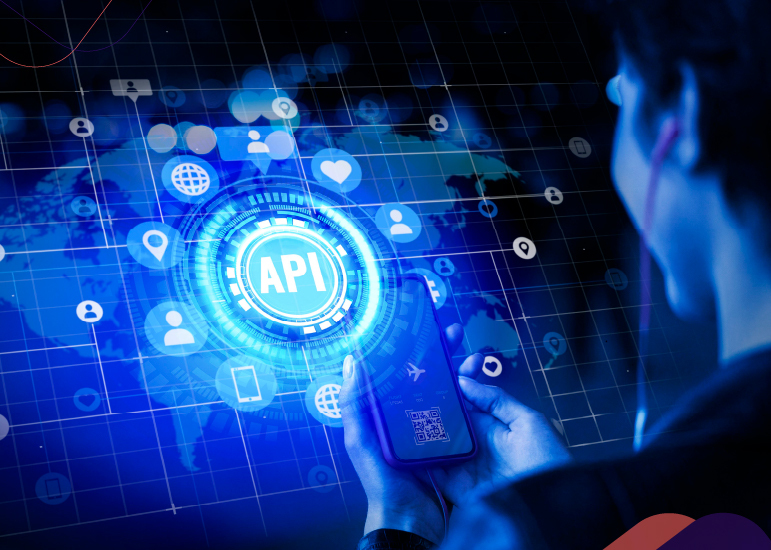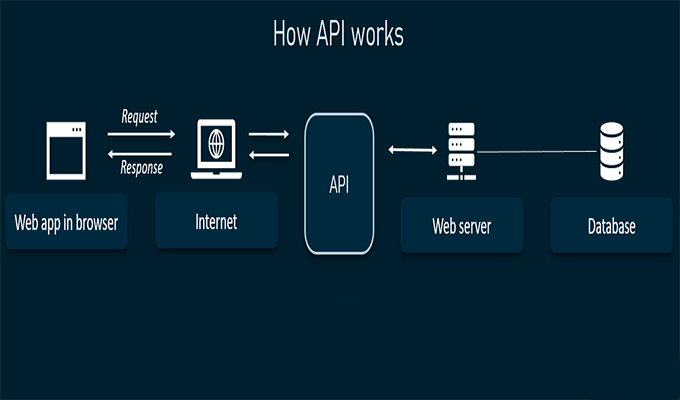
What Exactly Is An API?
Businesses can help open existing programs' capabilities to third independent programmers, commercial partners, and internal stakeholders through an application programming interface or API. Through such a specified gateway, software and services may interact and benefit from one other's information and capability. Engineers don't have to understand how such an API works; they still have to connect with the other goods & services using the interfaces. API usage has exploded in the last generation, to the point where many of the world's most common online apps would be impossible to create without services.

An API's operation
Application programming interface (API) is a set of rules and regulations that describe how systems and program interact. APIs operate as an intervening barrier between an web and reliable app development service, facilitating data flow across platforms.
Due to their role as a mediator, they can encapsulate capability among two methods. First, the API endpoint separates the receiving program from the service technician. To lessen the danger of service assaults, API calls usually contain authentication details, and also an API server can restrict access to minimize security flaws. Additionally, HTTP headers, passwords, and URL query parameters give extra safety protections to the data throughout the transaction.
The Following Is How An API Performs:
- A client program makes an Access token to get data, often referred to as a request. This query, which contains request verbs, parameters, and occasional request content, is sent from a program to the web server through the API's Uniform Resource Identifier (URI).
- The API gets a decision to the external programming or web host after getting a valid request.
- The server responds to the API with the data that was asked.
- The data is transferred to the receiving application via the API.
For Example:
1. Api used using curl:
curl -X 'GET'
'https://catfact.ninja/facts'
-H 'accept: application/json'
-H 'X-CSRF-TOKEN: ySj912bfXCEnxsD3iGNUYkLwYkVtviBjEMDispfe'
Result:
Result:
{
"current_page": 1,
"data": [
{
"fact": "Cats prefer to remain non-confrontational. They will not fight to show dominance, but rather to stake their territory. Cats will actually go to extremes to avoid one another in order to prevent a possible confrontation.",
"length": 219
},
{
"fact": "Despite imagery of cats happily drinking milk from saucers, studies indicate that cats are actually lactose intolerant and should avoid it entirely.",
"length": 148
},
{
"fact": "Cats have the largest eyes of any mammal.",
"length": 41
},
{
"fact": "Cats sleep 16 to 18 hours per day. When cats are asleep, they are still alert to incoming stimuli. If you poke the tail of a sleeping cat, it will respond accordingly.",
"length": 167
}
],
"next_page_url": "https://catfact.ninja/facts?page=2",
"path": "https://catfact.ninja/facts",
"per_page": 3,
"prev_page_url": null,
"to": 10,
"total": 332
}
2.
GET https://data.fixer.io/api/latest
result:
{
"success": false,
"error": {
"code": 101,
"type": "missing_access_key",
"info": "You have not supplied an API Access Key. [Required format: access_key=YOUR_ACCESS_KEY]"
}
}
Different Incredible Types Of API
Nowadays, the majority of APIs are online APIs, which reveal a platform's information and capabilities via the network. The four primary types of web APIs are as follows:
- Open APIs: Constitute open-sourced application programming interfaces (APIs) that you may use with the Internet protocol to retrieve. They have established API destinations, query, response forms and also accessible APIs.
- Composite APIs: Are a type of API that combines many information or service APIs. Such a service enables programmers to create a specific call to the many destinations. In a service-oriented architecture, composite APIs come in handy when a single job necessitates data from many sources.
- Internal APIs: Comprise application programming interfaces that are not accessible to other consumers. Such internal APIs are not open to the public and are meant to facilitate growth and cooperation across numerous development departments within the firm.
- Partner APIs: constitute application programming interfaces (APIs) made available to or provided by the company's core associates. Traditionally, programmers may use a public API developer portal to retrieve such APIs self-service. They would have to go through an onboarding procedure and obtain permission to use partner APIs.

Why Do We Require APIs? Why Are They Essential?
You may utilize an application programming interface to ease the method of monitoring current tools or generating new ones, even if you're administering digital resources or building new ones. The following are some of the most significant advantages of APIs:
- Data revenue models: Many firms prefer to make APIs freely available online, at least at first, to create a developer community surrounding their branding and establish ties with possible commercial partners. On the other hand, if the API provides access to critical digital assets, you may commercialize it by selling that privilege known as the API economy.
- Improved Collaboration: The typical company utilizes around 1,100 cloud apps, several APIs that are unconnected. APIs allow multiple channels and applications to connect systematically. Corporations may use this connection to simplify procedures and boost workforce cooperation. Many businesses would be disconnected and struggle from separate systems, jeopardizing motivation and effectiveness if APIs were not available.
- Sense Of Security: APIs provide an extra amount of stability across your information and a server, as previously mentioned. Utilizing identifiers, fingerprints, Transport Layer Security (TLS) protection, and establishing API portals to control and validate access and adopting good API administration, programmers may further increase API security.
- Enhanced Innovation: APIs enable firms to engage and interact with trading partners, enhance the customer experience to its current industry, and, eventually, expand into new markets that may produce significant profits and accelerate technological change.
Takeaway
API connections link the many aspects of your IT platform together, allowing them to communicate and transmit information smoothly. They're also significant because automating processes between different uses that were incorporated via API can eliminate time-consuming menial tasks, as well as adeptly transmit files that would otherwise necessitate data entry and result in modifying concerns, allowing users to do plenty of significant projects you must do, way quicker.
Looking for a trustworthy IT Services and Solutions provider? Connect with us today and get Cost-Effective Quotations! Give us a quick call at +91-7827171844!
































































